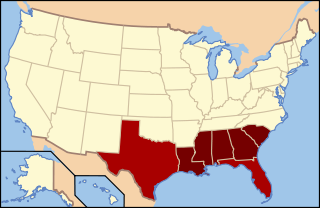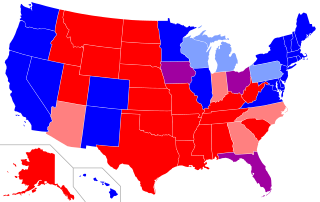Related Research Articles
The Whig Party was a political party that existed in the United States during the mid-19th century. Alongside the slightly larger Democratic Party, it was one of the two major parties in the United States between the late 1830s and the early 1850s as part of the Second Party System. Four presidents were affiliated with the Whig Party for at least part of their terms. Other prominent members of the Whig Party include Henry Clay, Daniel Webster, Rufus Choate, William Seward, John J. Crittenden, and John Quincy Adams. The Whig base of support was centered among entrepreneurs, professionals, planters, social reformers, devout Protestants, and the emerging urban middle class. It had much less backing from poor farmers and unskilled workers.

The 1852 United States presidential election was the 17th quadrennial presidential election, held on Tuesday, November 2, 1852. Democrat Franklin Pierce defeated Whig nominee General Winfield Scott. A third party candidate from the Free Soil party, John P. Hale, also ran and came in third place, but got no electoral votes.

The 1860 United States presidential election was the 19th quadrennial presidential election, held on Tuesday, November 6, 1860. In a four-way contest, the Republican Party ticket of Abraham Lincoln and Hannibal Hamlin won a national popular plurality, a popular majority in the North where states already had abolished slavery, and a national electoral majority comprising only Northern electoral votes. Lincoln's election thus served as the main catalyst of the states that would become the Confederacy seceding from the Union. This marked the first time that a Republican was elected president. It was also the first presidential election in which both major party candidates were registered in the same home state; the others have been in 1904, 1920, 1940, 1944, and 2016.

The States' Rights Democratic Party was a short-lived segregationist political party in the United States, active primarily in the South. It arose due to a Southern regional split in opposition to the regular Democratic Party. After President Harry S. Truman, the leader of the Democratic Party, ordered integration of the military in 1948 and other actions to address civil rights of African Americans, including the first presidential proposal for comprehensive civil and voting rights, many Southern white politicians who objected to this course organized themselves as a breakaway faction. They wished to protect the ability of states to maintain racial segregation. Its members were referred to as "Dixiecrats", a portmanteau of "Dixie", referring to the Southern United States, and "Democrat".

The Southern United States, sometimes Dixie, also referred to as the Southern States, the American South, the Southland, Dixieland, or simply the South, is a geographic and cultural region of the United States of America. It is between the Atlantic Ocean and the Western United States, with the Midwestern and Northeastern United States to its north and the Gulf of Mexico and Mexico to its south.
American electoral politics have been dominated by successive pairs of major political parties since shortly after the founding of the republic of the United States. Since the 1850s, the two largest political parties have been the Democratic Party and the Republican Party—which together have won every United States presidential election since 1852 and controlled the United States Congress since at least 1856. Despite keeping the same names, the two parties have evolved in terms of ideologies, positions, and support bases over their long lifespans, in response to social, cultural, and economic developments—the Democratic Party being the left-of-center party since the time of the New Deal, and the Republican Party now being the right-of-center party.

The Deep South or the Lower South is a cultural and geographic subregion of the Southern United States. The term was first used to describe the states which were most economically dependent on plantations and slavery. After the American Civil War ended in 1865, the region suffered economic hardship and was a major site of racial tension during and after the Reconstruction era. Before 1945, the Deep South was often referred to as the "Cotton States" since cotton was the primary cash crop for economic production. The civil rights movement in the 1950s and 1960s helped usher in a new era, sometimes referred to as the New South. The Deep South is part of the highly-religious, socially conservative Bible Belt and is currently a Republican Party stronghold.

The Compromise of 1877, also known as the Wormley Agreement or the Bargain of 1877, was an unwritten political deal in the United States to settle the intense dispute over the results of the 1876 presidential election, ending the filibuster of the certified results and the threat of political violence in exchange for an end to federal Reconstruction.
Southern Democrats are members of the U.S. Democratic Party who reside in the Southern United States.

Starting with the 2000 United States presidential election, the terms "red state" and "blue state" have referred to U.S. states whose voters vote predominantly for one party — the Republican Party in red states and the Democratic Party in blue states — in presidential and other statewide elections. By contrast, states where the vote fluctuates between the Democratic and Republican candidates are known as "swing states" or "purple states". Examining patterns within states reveals that the reversal of the two parties' geographic bases has happened at the state level, but it is more complicated locally, with urban-rural divides associated with many of the largest changes.

The 1988 United States House of Representatives elections was an election for the United States House of Representatives in November 8, 1988, to elect members to serve in the 101st United States Congress. They coincided with the election of George H. W. Bush as president. Although Bush won with a strong majority, his Republican Party lost a net of two seats to the Democratic Party, slightly increasing the Democratic majority in the House. It was the first time since 1960 that an incoming president's party lost seats in the House.

The 1954 United States House of Representatives elections was an election for the United States House of Representatives to elect members to serve in the 84th United States Congress. They were held for the most part on November 2, 1954, in the middle of Dwight Eisenhower's first presidential term, while Maine held theirs on September 13. Eisenhower's Republican Party lost eighteen seats in the House, giving the Democratic Party a majority that it would retain in every House election until 1994. This was nonetheless the first occasion when a Republican won a seat from Florida since 1882, and the first when the GOP won a seat from Texas since 1930.
In American politics, a conservative Democrat is a member of the Democratic Party with more conservative views than most Democrats. Traditionally, conservative Democrats have been elected to office from the Southern states, rural areas, the Rust Belt, and the Midwest. In 2019, the Pew Research Center found that 14% of Democratic and Democratic-leaning registered voters identify as conservative or very conservative, 38% identify as moderate, and 47% identify as liberal or very liberal.

The 1858–59 United States House of Representatives elections were held on various dates in various states between June 7, 1858, and December 1, 1859. Each state set its own date for its elections to the House of Representatives. 238 representatives were elected in the new state of Oregon, the pending new state of Kansas, and the other 32 states before the first session of the 36th United States Congress convened on December 5, 1859. They were held during President James Buchanan's term.
The Unionist Party, later known as the Unconditional Union Party in the border states, was a political party in the United States started after the Compromise of 1850 to define politicians who supported the Compromise. It was used primarily as a label by politicians who did not want to affiliate with the Republicans, or wished to win over anti-secession Democrats. Members included Southern Democrats who were loyal to the Union as well as elements of the old Whig Party and other factions opposed to a separate Southern Confederacy.
New York’s 27th congressional district was a congressional district for the United States House of Representatives in western New York. It included all of Orleans, Genesee, Wyoming, and Livingston counties and parts of Erie, Monroe, Niagara, and Ontario counties. The district contained most of the eastern and southern suburbs of Buffalo, most of the southern suburbs of Rochester, as well as large rural areas to the east and south. The seat was last occupied by Republican Chris Jacobs, who won a special election on June 23, 2020. Previously, it had been vacant from October 1, 2019, when Republican incumbent Chris Collins resigned after pleading guilty to charges of insider trading.

The Missouri Compromise was a federal legislation of the United States that balanced desires of northern states to prevent the expansion of slavery in the country with those of southern states to expand it. It admitted Missouri as a slave state and Maine as a free state and declared a policy of prohibiting slavery in the remaining Louisiana Purchase lands north of the 36°30′ parallel. The 16th United States Congress passed the legislation on March 3, 1820, and President James Monroe signed it on March 6, 1820.

American political ideologies conventionally align with the left–right political spectrum, with most Americans identifying as conservative, liberal, or moderate. Contemporary American conservatism includes social conservatism, classical liberalism and economic liberalism. The former ideology developed as a response to communism and the civil rights movement, while the latter two ideologies developed as a response to the New Deal. Contemporary American liberalism includes progressivism, welfare capitalism and social liberalism, developing during the Progressive Era and the Great Depression. Besides modern conservatism and liberalism, the United States has a notable libertarian movement, developing during the mid-20th century as a revival of classical liberalism. Historical political movements in the United States have been shaped by ideologies as varied as republicanism, populism, separatism, fascism, socialism, monarchism, and nationalism.

The 1890 United States elections occurred in the middle of Republican President Benjamin Harrison's term. Members of the 52nd United States Congress were chosen in this election. The Republicans suffered major losses due to the Panic of 1890 and the unpopularity of the McKinley Tariff. The Populist Party also emerged as an important third party.
The Opposition Party was a party identification under which Northern anti-slavery politicians, formerly members of the Democratic and the Whig Parties, briefly ran in the 1850s in response to the expansion of slavery into the new territories. It was one of the movements that arose from the political chaos in the decade before the American Civil War in the wake of the Compromise of 1850. The movement had arisen before and was quickly subsumed by the coalescence of the Republican Party in 1856.
References
- ↑ Richardson, Darcy, G (2004). Others: Third Party Politics from the Nations Founding to the Rise and Fall of the Greenback-Labor Party. Amazon: iUniverse. pp. 148–164. ISBN 978-0595317233.
{{cite book}}: CS1 maint: multiple names: authors list (link)